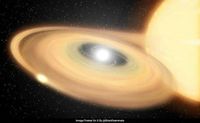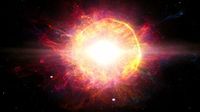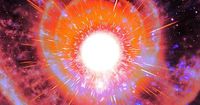A spectacular cosmic event is on the horizon: a rare nova explosion so bright that it will be visible to the naked eye.
Astronomers have been closely monitoring a small constellation, eagerly awaiting the eruption of a nearby binary star system. The long wait may finally be over—recent calculations suggest the nova could explode as soon as Thursday, March 27.
The Blaze Star’s Explosive Cycle
T Coronae Borealis (T CrB), also known as the Blaze Star, is a binary system located 3,000 light-years from Earth. It undergoes recurring nova eruptions approximately every 79 years, and the next one is imminent. For the past decade, the Blaze Star has been exhibiting behavior eerily similar to the lead-up to its last eruption nearly 80 years ago, according to NASA.
The window for this celestial event opened in February 2024 and remains active. Enthusiasts have been watching the night sky, anticipating the moment the star ignites in a brilliant flash. A study published in Research Notes of the American Astronomical Society predicts that the nova is most likely to erupt on March 27, 2025. However, if the explosion does not occur on this date, astronomer Jean Schneider of the Paris Observatory has identified two alternative possibilities: November 10, 2025, and June 25, 2026.
The Science Behind the Explosion
T CrB is a binary star system consisting of a white dwarf and a red giant. The red giant, slightly more massive than our Sun, orbits the white dwarf every 227 days at a distance comparable to that between the Sun and Venus. The white dwarf exerts an intense gravitational pull, slowly stripping hydrogen from its companion. This stolen material forms an accretion disk, which builds up pressure and heat over time. When the conditions reach a critical point, a thermonuclear explosion ignites, ejecting accumulated material into space in a spectacular nova event.
Unlike a supernova, which destroys a star, this nova leaves the white dwarf intact, allowing the cycle to repeat every few decades. The first recorded eruption of T CrB occurred over 800 years ago, and its periodic bursts continue to captivate astronomers.
What to Expect in the Night Sky
Once the explosion occurs, it will shine brightly for several days, appearing as a new star in the sky before fading away. Currently, T CrB is too faint to see without a telescope, at a magnitude of +10. However, after the nova, it will brighten to +2 magnitude, making it almost as luminous as the North Star. The event will be visible from the Northern Hemisphere, within the Corona Borealis constellation, which forms an arc in the night sky. If you want to witness this rare celestial show, be sure to look up—this won’t happen again for nearly 80 years.
Anticipation and Uncertainty
Keep your eyes peeled, because a dim star is about to quite literally go nuclear. And guess what? Its outburst will be visible to the naked eye, providing a once-in-a-lifetime opportunity to witness a rare stellar explosion known as a nova. The star, T Coronae Borealis, is believed to erupt roughly every 80 years.
After closely monitoring its activity, astronomer Jean Schneider at the Paris Observatory has calculated that it’ll erupt again this Thursday, March 27, according to a paper he published with the American Astronomical Society last year. Prepare to give our scientific minds some leeway, however. T Coronae Borealis was predicted to go nova last year, after it exhibited dips in brightness, a telltale sign of an impending explosion, but the blast never came.
Now, armed with more data, Schneider has narrowed the several-month window of previous predictions by others in the field down to a single day. If this week's a no-show, the next possible date this year will be November 10, 2025. Astronomers are excited, but stress that it's not guaranteed. "Since last September, detailed observations of the star have revealed variations that suggest the imminent arrival of this long-awaited explosion," Franck Marchis, a SETI Institute astronomer who was not involved in the work, recently told Forbes. "However, as the study is still theoretical, its conclusions remain uncertain."
How to Spot the Blaze Star
If you're interested in seeing the nova eruption of T Coronae Borealis, you need to know where in the night sky to look for it. It's part of the constellation known as the Corona Borealis, which you can find in the Northern Celestial Hemisphere. This means anyone who is North of the 50th Parallel South can see the entire constellation.
You can look to the bottom-most segment of Corona Borealis to see the Blaze Star when it goes off. That said, you'd be best served by a stargazing app that will help you locate constellations and stars, such as Google Sky, Stellarium, or Star Tracker. When you're visually hunting for a speck of light in the night sky, a stargazing app makes it a whole lot easier to find it, and actually know that you found it.
As for what it will look like from Earth should it happen on March 27, November 10, or June 25, it’ll look like a brand-new bright and shining star in the sky that will be visible at the lower tip of the Corona Borealis constellation, wedged between the constellations Hercules and Boötes.
A Celestial Event to Remember
Scientists and skywatchers view this explosion as a major scientific occurrence. When T CrB explodes, it creates both a remarkable visual show and a major scientific discovery. Dr. Hounsell, a NASA Goddard Space Flight Center research scientist who studies nova events, believes that observers can enjoy a “once-in-a-lifetime event” to study cosmic phenomena and conduct their own inquiries and data collection.
Such cosmic events enable scientists to study star behavior and binary star patterns during their entire lifetimes. By studying these processes, scientists develop a better understanding of stellar evolution because they examine thermonuclear explosions in white dwarfs. Scientists expect T Coronae Borealis to detonate soon, thus presenting skywatchers of all levels with an exclusive opportunity.
You should monitor the night sky because we are approaching the predicted day for observing this phenomenon, which only appears every eighty years. Astronomers of all experience levels can anticipate unforgettable moments during this upcoming celestial event, which links humanity to the vast active universe.
For more information about this possible event, you can check NASA’s official website.






